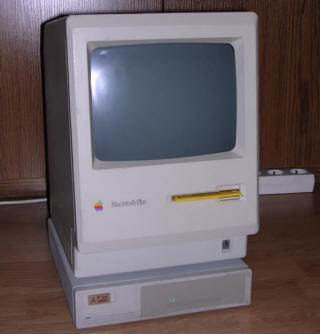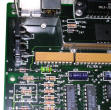Macintosh Plus
Apple's third model of Macintosh line (except Lisa/Mac XL) came with many new features. 1MB of RAM, expandable to 4MB, made Plus good in data processing. It was the first Mac to have SCSI port to connect external hard drives (although useless in early units because of ROM bug) and 800kB floppy disk drive instead of earlier 400K. It was using its own keyboard and mouse connectors. Plus was sold until 1990, when Apple decided to use Macintosh Classic as cheaper alternative.
| Model No: | M0001A | |
| Year: | 1987 | |
| Discontinued: | 1990 | |
| CPU: | Motorola 68000 8MHz | |
| RAM: | 1MB | |
| Max. RAM: | 4MB | |
| RAM Type: | 30-pin SIMMs | |
| Hard disk: | None built-in | |
| Floppy drives: | 1 800K 3.5" | |
| Other drives: | None | |
| Graphics: | 512x342 monochrome | |
| Sound: | 1 8-bit/22kHz speaker | |
| Display: | Built-in 9" CRT | |
| Dedicated OS: | Mac System 3 | |
| Maximum OS: | Mac System 7.5.5 | |
| Expansions: | None. | |
|
Peripherals in collection: |
||
| Connectors: | - Keyboard - Sound output mono jack - Mouse (DB9F) - External floppy drive connector - External SCSI HDD connector - 2 RS-422 serial ports (for printer and modem) |
|
Origin of my unit is not known. I found it in recycling plant and traded for 2 broken mainboards. I can see that it was kept in a good shape earlier - it has even original floppy drive head fixing tool. Unfortunately it's broken as it was kept a few days outdoors and thrown a few times.
During installation of external hard disk drive, use ID 6 if you can. This will make boot faster as Plus checks drives in 6,5,4,3,2,1,0 order. Start-up disk selection from control panel does NOT work, as it works since Mac SE.
Here you'll find: Easter egg, Memory upgrade, Keyboard
Interesting facts...
On the left side of the computer you can see 2 buttons. If not, you have to look into grilles there - they will be 2 big buttons. One of them resets computer while another one runs internal debugger. This piece of software pops in as a white rectangle with text cursor and allows to do simple operations in memory, reading, dumping, writing bytes, executing programs or running program in memory from specified offset.
Last function can be used to reveal hidden routines in memory. If you type "G 40E118" there and press Enter, you'll get message "Stolen from Apple Computers". This small bitmap was a trap for companies who wanted to copy Macintosh including its ROM and sell it as their own product. Some companies did it, but they made a new, compatible ROM (for example Executor emulator contained re-written ROM to run Mac programs on PC - thanks to Jorpho for info). Some others just copied a whole ROM changing "Apple" to their name in all strings. Because "find-and-replace" works only with text, not bitmaps, this "Stolen from Apple" survives any changes except deep analysis of ROM... which was done only while writing a new one. This was an easy proof that ROM was copied.
Memory Upgrade
Memory upgrading procedure is quite simple if you know what you're doing. First, you have to get 30-pin SIMM modules with sufficient timings. Mac was designed to work with 120-150ns SIMMs, some 80ns should do the job, while 60-70 may cause errors. To test memory you can run Level 2 Testing from bootable MacTest 7.0 service diskette (if you get one). Mac was designed to support 8-bit SIMMs, but 9-bit (8+parity) should work. If you have 8 or 9-chip modules and 3-chip modules, these 8/9-chip ones work in more cases.
Your Mac Plus has 4 SIMM sockets. Here you can install memory in the following configurations:
- 512K - two 256K SIMMs in sockets closer to CPU, lower 2 sockets empty.
- 1MB - 4 256K SIMMs.
- 2MB - 2 1MB SIMMs in sockets closer to CPU, lower 2 sockets empty.
- 2.5MB - 2 1MB SIMMs in sockets closer to CPU, 2 256K SIMMs populating other two sockets.
- 4MB - 4 1MB SIMMs.
Generally, install "ONE ROW" resistor when only 2 SIMMs (doesn't matter which size) are installed.
Install "256K BIT" resistor if all of SIMMs are 256K (1MB config).
It means that to install 4MB, there must be no resistors. While upgrading, cut only one resistor's pin, then move it not to connect - it helps with downgrading.
Resistors are 150 Ohms.
There is an untested Arduino project of PS/2 keyboard for it: https://github.com/trekawek/mac-plus-ps2 .






